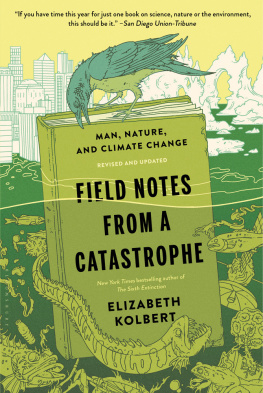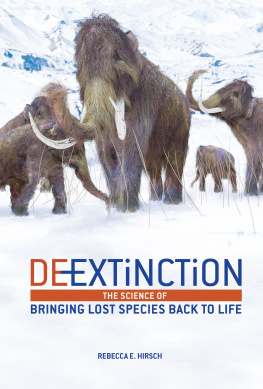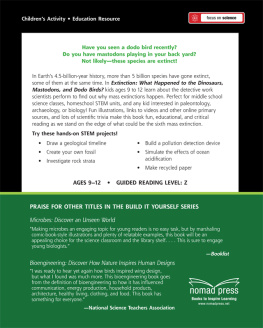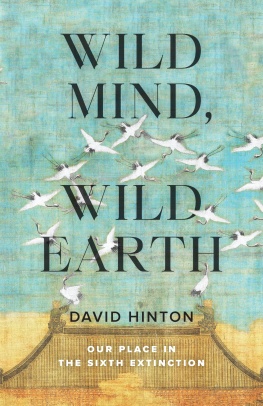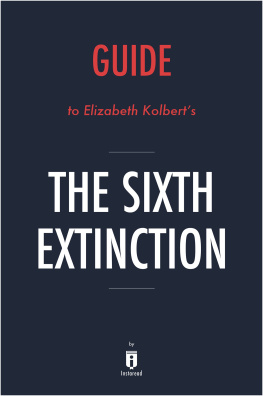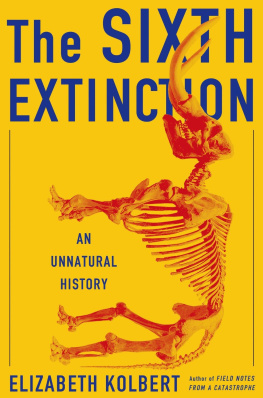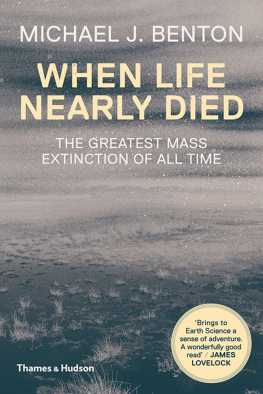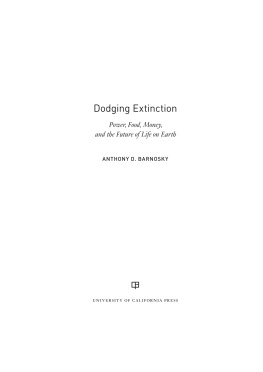
The author and publisher have provided this e-book to you for your personal use only. You may not make this e-book publicly available in any way.
Copyright infringement is against the law. If you believe the copy of this e-book you are reading infringes on the authors copyright, please notify the publisher at: us.macmillanusa.com/piracy .
T HE S IXTH E XTINCTION: A N U NNATURAL H ISTORY
Copyright 2014 by Elizabeth Kolbert.
All rights reserved.
For information, address
Henry Holt and Co.,
175 Fifth Avenue, New York, N.Y. 10010.
www.henryholt.com
Jacket photograph from the National Museum of Natural History, courtesy of the Smithsonian Institution
e-ISBN 978-0-8050-9979-9
First Edition: February 2014
If there is danger in the human trajectory, it is not so much in the survival of our own species as in the fulfillment of the ultimate irony of organic evolution: that in the instant of achieving self-understanding through the mind of man, life has doomed its most beautiful creations. E. O. WILSON Centuries of centuries and only in the present do things happen. JORGE LUIS BORGES
CONTENTS
AUTHORS NOTE
Though the discourse of science is metric, most Americans think in terms of miles, acres, and degrees Fahrenheit. All the figures in this book are given in English units, except where specially noted.
PROLOGUE
Beginnings, its said, are apt to be shadowy. So it is with this story, which starts with the emergence of a new species maybe two hundred thousand years ago. The species does not yet have a namenothing doesbut it has the capacity to name things.
As with any young species, this ones position is precarious. Its numbers are small, and its range restricted to a slice of eastern Africa. Slowly its population grows, but quite possibly then it contracts againsome would claim nearly fatallyto just a few thousand pairs.
The members of the species are not particularly swift or strong or fertile. They are, however, singularly resourceful. Gradually they push into regions with different climates, different predators, and different prey. None of the usual constraints of habitat or geography seem to check them. They cross rivers, plateaus, mountain ranges. In coastal regions, they gather shellfish; farther inland, they hunt mammals. Everywhere they settle, they adapt and innovate. On reaching Europe, they encounter creatures very much like themselves, but stockier and probably brawnier, who have been living on the continent far longer. They interbreed with these creatures and then, by one means or another, kill them off.
The end of this affair will turn out to be exemplary. As the species expands its range, it crosses paths with animals twice, ten, and even twenty times its size: huge cats, towering bears, turtles as big as elephants, sloths that stand fifteen feet tall. These species are more powerful and often fiercer. But they are slow to breed and are wiped out.
Although a land animal, our speciesever inventivecrosses the sea. It reaches islands inhabited by evolutions outliers: birds that lay foot-long eggs, pig-sized hippos, giant skinks. Accustomed to isolation, these creatures are ill-equipped to deal with the newcomers or their fellow travelers (mostly rats). Many of them, too, succumb.
The process continues, in fits and starts, for thousands of years, until the species, no longer so new, has spread to practically every corner of the globe. At this point, several things happen more or less at once that allow Homo sapiens , as it has come to call itself, to reproduce at an unprecedented rate. In a single century the population doubles; then it doubles again, and then again. Vast forests are razed. Humans do this deliberately, in order to feed themselves. Less deliberately, they shift organisms from one continent to another, reassembling the biosphere.
Meanwhile, an even stranger and more radical transformation is under way. Having discovered subterranean reserves of energy, humans begin to change the composition of the atmosphere. This, in turn, alters the climate and the chemistry of the oceans. Some plants and animals adjust by moving. They climb mountains and migrate toward the poles. But a great manyat first hundreds, then thousands, and finally perhaps millionsfind themselves marooned. Extinction rates soar, and the texture of life changes.
No creature has ever altered life on the planet in this way before, and yet other, comparable events have occurred. Very, very occasionally in the distant past, the planet has undergone change so wrenching that the diversity of life has plummeted. Five of these ancient events were catastrophic enough that theyre put in their own category: the so-called Big Five. In what seems like a fantastic coincidence, but is probably no coincidence at all, the history of these events is recovered just as people come to realize that they are causing another one. When it is still too early to say whether it will reach the proportions of the Big Five, it becomes known as the Sixth Extinction.
The story of the Sixth Extinction, at least as Ive chosen to tell it, comes in thirteen chapters. Each tracks a species thats in some way emblematicthe American mastodon, the great auk, an ammonite that disappeared at the end of the Cretaceous alongside the dinosaurs. The creatures in the early chapters are already gone, and this part of the book is mostly concerned with the great extinctions of the past and the twisting history of their discovery, starting with the work of the French naturalist Georges Cuvier. The second part of the book takes place very much in the presentin the increasingly fragmented Amazon rainforest, on a fast-warming slope in the Andes, on the outer reaches of the Great Barrier Reef. I chose to go to these particular places for the usual journalistic reasonsbecause there was a research station there or because someone invited me to tag along on an expedition. Such is the scope of the changes now taking place that I could have gone pretty much anywhere and, with the proper guidance, found signs of them. One chapter concerns a die-off happening more or less in my own backyard (and, quite possibly, in yours).
If extinction is a morbid topic, mass extinction is, well, massively so. Its also a fascinating one. In the pages that follow, I try to convey both sides: the excitement of whats being learned as well as the horror of it. My hope is that readers of this book will come away with an appreciation of the truly extraordinary moment in which we live.
CHAPTER I
THE SIXTH EXTINCTION
Atelopus zeteki
The town of El Valle de Antn, in central Panama, sits in the middle of a volcanic crater formed about a million years ago. The crater is almost four miles wide, but when the weather is clear you can see the jagged hills that surround the town like the walls of a ruined tower. El Valle has one main street, a police station, and an open-air market. In addition to the usual assortment of Panama hats and vividly colored embroidery, the market offers what must be the worlds largest selection of golden-frog figurines. There are golden frogs resting on leaves and golden frogs sitting up on their haunches andrather more difficult to understandgolden frogs clasping cell phones. There are golden frogs wearing frilly skirts and golden frogs striking dance poses and golden frogs smoking cigarettes through a holder, after the fashion of FDR. The golden frog, which is taxicab yellow with dark brown splotches, is endemic to the area around El Valle. It is considered a lucky symbol in Panama; its image is (or at least used to be) printed on lottery tickets.
As recently as a decade ago, golden frogs were easy to spot in the hills around El Valle. The frogs are toxicits been calculated that the poison contained in the skin of just one animal could kill a thousand average-sized micehence the vivid color, which makes them stand out against the forest floor. One creek not far from El Valle was nicknamed Thousand Frog Stream. A person walking along it would see so many golden frogs sunning themselves on the banks that, as one herpetologist who made the trip many times put it to me, it was insaneabsolutely insane.
Next page


